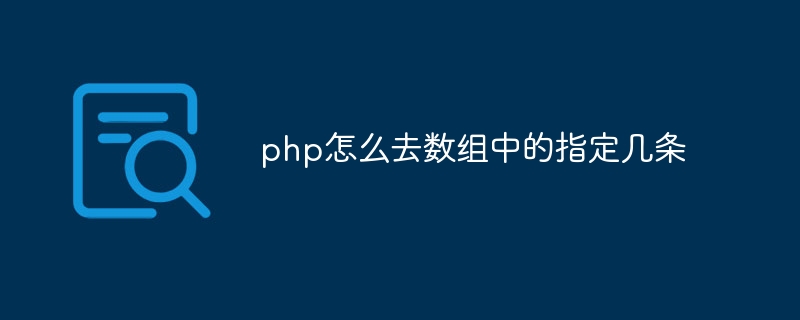
php uses subscripts, array_key_exists() function, isset() function, unset() function and array_splice() function to specify a few items in the array. Detailed introduction: 1. Subscript, the subscript starts from 0 and increases in sequence; 2. array_key_exists() function, this function accepts two parameters, the first parameter is the key to be checked, and the second parameter is the array to be checked. ;3. The isset() function accepts one parameter, which is the array element to be checked, etc.

The operating environment of this tutorial: windows10 system, php8.1.3 version, DELL G3 computer.
PHP is a widely used programming language that provides rich array operation functions. In PHP, we can use a variety of methods to access and modify specified values in an array. This article will introduce several commonly used methods.
1. Use subscripts to access array elements
In PHP, array elements can be accessed through subscripts. The subscripts start from 0 and increase sequentially. For example, for an array named $numbers, we can use $numbers[0] to access the first element, $numbers[1] to access the second element, and so on.
Sample code:
$numbers = [1, 2, 3, 4, 5]; echo $numbers[2]; // 输出3
2. Use the array_key_exists() function to check whether the specified key exists in the array
If we want to check whether a specific key exists in the array Key, you can use the array_key_exists() function. This function accepts two parameters, the first parameter is the key to check, and the second parameter is the array to check.
Sample code:
$student = [
'name' => 'John',
'age' => 20,
'grade' => 'A'
];
if (array_key_exists('age', $student)) {
echo $student['age']; // 输出20
}3. Use isset() function to check whether an array element has been set
If we want to check whether an element in the array has been set, You can use the isset() function. This function accepts one parameter, which is the array element to check.
Sample code:
$fruits = ['apple', 'banana', 'orange'];
if (isset($fruits[1])) {
echo $fruits[1]; // 输出banana
}4. Use the unset() function to delete the specified element in the array
If we want to delete an element from the array, we can use unset ()function. This function accepts one parameter, the array element to be deleted.
Sample code:
$colors = ['red', 'green', 'blue']; unset($colors[1]); print_r($colors); // 输出Array ( [0] => red [2] => blue )
5. Use the array_splice() function to replace the specified element in the array
If we want to replace an element in the array, we can use array_splice ()function. This function accepts three parameters, the first parameter is the array to be replaced, the second parameter is the position to be replaced, and the third parameter is the new value to be replaced.
Sample code:
$names = ['Alice', 'Bob', 'Charlie']; array_splice($names, 1, 1, 'David'); print_r($names); // 输出Array ( [0] => Alice [1] => David [2] => Charlie )
In summary, PHP provides a variety of methods to access and modify specified values in the array. We can access an array element using a subscript, check if a specified key exists in the array using the array_key_exists() function, check if an array element is set using the isset() function, delete a specified element in an array using the unset() function, and use array_splice () function replaces the specified element in the array. Depending on the specific needs, we can choose the appropriate method to operate the array .
The above is the detailed content of How to specify a few items in an array in php. For more information, please follow other related articles on the PHP Chinese website!